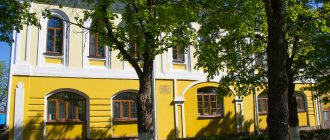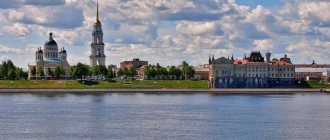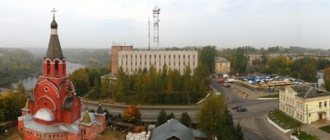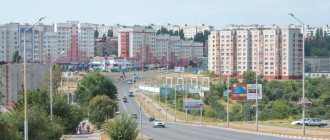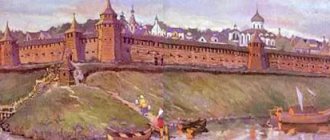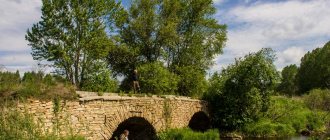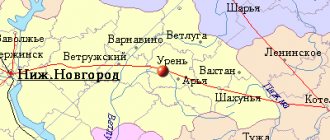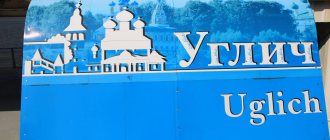Sights of the city of Furmanov - Furmanov - Ivanovo region - Catalog of articles
Church of the Ascension of the Lord The oldest (XVIII-XIX centuries) Furmanovskaya church.
People call the temple “White”, distinguishing it from the local Church of the Mother of God “Joy of All Who Sorrow”, which is made of red brick. The wooden Ascension Church was first mentioned in 1614. The brick church was erected in 1727 at the request of the owner of the village, General - Major Prince I. F. Baryatinsky - and radically rebuilt into the second floor. XIX century Furmanov Art Gallery named after D. A. Trubnikov
The museum presents historical, archaeological and local history exhibitions, and holds regular creative meetings. The museum building is a 19th-century residential building, which has largely preserved the layout and interior decoration: a three-story mansion with a basement and an underground passage. The decoration of the house is a stone hall and a veranda with access to an ancient park.
Memorial room-museum of the Ivanovo poet Mikhail Dudin in the village of Shirokovo The basis of the fund is materials about the life and work of the poet, literary collections of Mikhail Dudin. Among the valuable exhibits are books from the poet’s personal library. The majority of the fund consists of local history materials: paintings by artists V. Zhuravlev and Y. Pyatov with views of the surrounding area.
Museum of History and Local Lore at the Higher Professional Lyceum No. 7
Historical and local history materials tell about the past of Sereda, introduce the owners of the village, representatives of the boyar and princely families who owned the surrounding lands.
St. Michael's Church
According to legend, the first wooden church was built on this site by the monks of this particular monastery. The corresponding mention in 1565 in the hundredth of the Kostroma books, books of Prince Alexander Dimitrievich Danilov and Ondrei Vasiliev, son of Timofeevich Beznosov and his comrades: “Ipatsky Monastery ... Ipatsky Monastery in the Kostroma district in the Yeletsk volost, the village of Mikhailovskoye on the river on Shacha, given to Prince David Feodorovich Galitsky ..."
Memorial Museum of D.A. Furmanov
On October 26, 2005, after a long period of 10 years, the D.A. Furmanov Museum reopened its doors to residents and guests of the city of Furmanov. In the museum exhibition “Medium. A View from the 21st Century,” dedicated to the history of the city in the 19th – early 20th centuries, presents a panorama of the life of the region with its political and social upheavals. The exhibition is based on originals, a significant part of which: documents, paintings, household items, rare books, clothing. The picturesque row is represented by the works of the artist D.A. Trubnikova (1885-1947).
allsity.ucoz.net
Attractions
Temple of the Mother of God "Joy of All Who Sorrow"
The city is included in the “Golden Ring of Russia” tourist route. Among the architectural monuments are the house in which D. A. Furmanov was born, the house where the artist D. A. Trubnikov lived and worked (lost in the 80s of the twentieth century), the estates of manufacturers Gorbunov and Losev, an art gallery, a temple of all Joy of the Sorrowful (1886-97).
Furmanov – Mycicerone – travel and tourism in cities and countries
Material from Mycicerone - travel and tourism in cities and countries
[edit] A little about Furmanov
Furmanov is a regional center in the north of the Ivanovo region of Russia, located on the banks of the Shacha River, a right tributary of the Volga, 30 kilometers northeast of Ivanovo.
The city gave the world a commissar in the Chapaev Division and a writer Dmitry Andreevich Furmanov (1891-1926), whose name the city bears since March 13, 1941.
[edit] Furmanov districts
[edit] How to get to Furmanov
[edit] by plane
The nearest airport is in Ivanovo.
[edit] by train
The Nizhny Novgorod - Ivanovo - Yaroslavl railway passes through Furmanov. Trains from the Volga region to St. Petersburg and Yaroslavl stop here, including two daily Ivanovo↔Yaroslavl trains.
[edit] by bus
[edit] by car
Furmanov is located on the A113 highway Kostroma - Ivanovo.
[edit] on the ship
The river is not navigable.
[edit] Urban transport Furmanov
[edit] Hotels in Furmanovo
Address: Ivanovo region, Furmanov, Sovetskaya street, 12 Phone: +7(49341)2-15-71 Description:
[edit] Sights of Furmanov
- A secondary school building built in 1929-30 at 28 Revolutsionnaya Street.
- The former estate of the manufacturer Gorbunov at Sovetskaya Street, 6.
- The former estate of the merchant Losev at Sovetskaya Street, 9 and 10.
- Orthodox Church of the Intercession of the Blessed Virgin Mary on Sovetskaya Street, 14.
- Old Believer Chapel on Sovetskaya Street, 15.
- Monument to D.A. Furmanov by sculptor N.V. Dydykin on Socialist Street, erected in 1960.
- Orthodox Church of All Who Sorrow Joy at 36 Socialist Street, built at the end of the 19th century.
- Church of the Nativity of the Blessed Virgin Mary, built in the late 1990s on the territory of a spinning factory.
[edit] Museums in Furmanovo
Address: Ivanovo region, Furmanov, Bolshaya Furmanovskaya street, 69 Phone: +7(49341)2-09-00 Opening hours: 11:00-17:00, Thursday 14:30-21:00, except Mondays and last Friday every month Tickets: Description: In this house, according to legend, the writer and commissar Dmitry Furmanov was born.
- Furmanov Art Gallery named after D.A. Trubnikov
Address: Ivanovo region, Furmanov, Sovetskaya street, 6 Telephone: Opening hours: Tickets: Description:
- Museum of History and Local Lore at the Higher Professional Lyceum No. 7
Address: Ivanovo region, Furmanov, Timiryazeva street, 43 Phone: +7(49341)2-50-58 Opening hours: Tickets: Description:
[edit] Entertainment in Furmanovo
[edit] Food in Furmanovo
[edit] Information on the Internet about Furmanov
- furmanov.net - website of the district Administration
- furmanoff.ru - city website
www.mycicerone.ru
Story
Formed on the basis of the growth of factory workers' settlements. It received its original name from the largest village - Sereda-Upino (mentioned since 1628). In 1918 it received city status. In the period from 1918 to 1941 the city was called Sereda, on March 13, 1941 it was renamed in honor of the (presumably) Russian writer Dmitry Andreevich Furmanov, who was born here.
Furmanovskoye urban settlement on the map of Furmanovsky district
In 2005, the city of Furmanov was given the status of an urban settlement within the Furmanovsky municipal district.
Furmanov (city) is... What is Furmanov (city)?
This term has other meanings, see Furmanov.
Losev's mansion (Gallery named after Trubnikov) Furmanov is a city (since 1918) in Russia, the administrative center of the Furmanovsky municipal district of the Ivanovo region.
Geography
The city is located on the non-navigable Shacha River (a tributary of the Volga), 33 km from Ivanovo, which is connected by a national highway (Route A113 Kostroma - Ivanovo), as well as by railway.
Story
Formed on the basis of the growth of factory workers' settlements. It received its original name from the largest village - Sereda-Upino (mentioned since 1628). In 1918 it received city status. In the period from 1918 to 1941 the city was called Sereda, on March 13, 1941 it was renamed in honor of the (presumably) Russian writer Dmitry Andreevich Furmanov, who was born here. Although it has already been proven that D. A. Furmanov was born in the village of Aleshino, Yaroslavl region. and in Sereda little Dmitry was only baptized. [source not specified 177 days]
Furmanovskoye urban settlement on the map of Furmanovsky district
In 2005, the city of Furmanov was given the status of an urban settlement within the Furmanovsky municipal district.
Now the city is developing according to the master plan developed by Baza LLC in 2009. The total length of 226 streets and roads is 120 km. The city area is 15.59 square meters. km, area 763.2 sq. km. Population - 37.5 thousand people (as of 01/01/2009).
Economy
The largest enterprises in the city are the Furmanovsky Foundry and Mechanical Plant (it went bankrupt and is currently in disrepair), the machine-building plant (since 2011 it has been completely bankrupt, the staff was fired), 3 spinning and weaving enterprises: Furmanovskaya Factory No. 1 LLC, JSC Furmanovskaya Spinning and Weaving Factory No. 2, Spinning and Weaving Factory No. 3 of the Shuya Calico Holding, sewing enterprises, a bakery, a dairy plant, forest industry enterprises. In 2010, self-produced goods were shipped, work and services were performed in-house for manufacturing activities at large and medium-sized enterprises - 1.33 billion rubles. The Limaton Upakovka enterprise, which produces various types of packaging material, is located in the former premises.
Attractions
Temple of the Mother of God “Joy of All Who Sorrow”
The city is included in the tourist route “Golden Ring of Russia”. Among the architectural monuments are the house in which D. A. Furmanov was born, the house where the artist D. A. Trubnikov lived and worked (lost in the 80s of the twentieth century), the estates of manufacturers Gorbunov and Losev, an art gallery, a temple of all Joy of the Sorrowful (1886-97).
Church of the Ascension of the Lord (parish of the Ascension Church)
The oldest (XVIII-XIX centuries) Furmanovskaya church. People call the temple “White”, distinguishing it from the local Church of the Mother of God “Joy of All Who Sorrow”, which is made of red brick. The wooden Ascension Church was first mentioned in 1614. The brick church was erected in 1727 at the request of the owner of the village, General - Major Prince I. F. Baryatinsky - and radically rebuilt in the second half of the 19th century. This temple is valuable scientifically and artistically, since the ancient part (refectory, altar, base of the bell tower) dates back to the 18th century. The remaining parts of the temple are from the end of the 19th century. The church typologically belongs to three-part, pillarless, single-apse churches with a semi-circular altar, an extensive pillarless refectory and a tiered bell tower. The temple belongs to the type of cross-domed, multi-domed churches with three altars - a central rectangular one and two side semicircular ones. The upper volumes of the temple and the bell tower have not survived. Judging by the original decoration preserved in the upper part of the quadrangle, the temple was designed in the traditions of pre-Petrine architecture.[2]
Memorial Museum of Dmitry Furmanov
The museum was revived in 2005[3]. In the exhibition “Wednesday. A View from the 21st Century,” dedicated to the history of the city from the 19th century to the beginning. XX centuries, presents a panorama of life in the region with its political and social upheavals. The exhibition is based on originals - documents, paintings, household items, rare books, clothing. The picturesque row is represented by the works of the artist D. A. Trubnikov (1885-1947). In one of the halls of the museum, the memorial room of the Furmanov family, where Dmitry Furmanov (1891-1926) was born and spent his childhood, has been restored. His life and career are also presented in the historical part of the exhibition. There you can see lifetime editions of the author of the famous novel “Chapaev”, original photographs and personal letters of the writer whose name the city bears.[4]
Furmanov Art Gallery named after D. A. Trubnikov
The gallery was created in 1989 on the initiative of a group of enthusiasts who sought to preserve the creative heritage of D. A. Trubnikov[5]. The museum presents historical, archaeological and local history exhibitions, and holds regular creative meetings. The museum building is a 19th-century residential building, which has largely preserved the layout and interior decoration: a three-story mansion with a basement and an underground passage. The decoration of the house is a stone hall and a veranda with access to an ancient park.
Museum of History and Local Lore at the Higher Professional Lyceum No. 7
The museum, opened on April 24, 2002[6], contains exhibits telling about the history of the city and region from ancient times to the present day - minerals, tools of primitive man, mammoth tusks and other trophies of archaeological excavations. Historical and local history materials tell about the past of Sereda, introduce the owners of the village, representatives of the boyar and princely families who owned the surrounding lands. On the stands are photographs of the manufacturers Klementyevs, Gorbunovs, Skvortsovs-Pavlovs, Nasedkins, Stulovs - the founders of textile production. Trade Sereda is represented by images of merchant mansions and fair festivities. The exhibition reflects the years of revolution and civil war, the period of socialist construction and the creation of collective farms, the years of the Great Patriotic War and post-war reconstruction. The museum's attraction is a historically accurate recreation of a peasant farmstead from the end of the 19th century, as well as the interiors of a city dweller's home from the 1940s-1950s.
Versions about the origin of the name
There is no single version about the origin of the name of the village. Some researchers believe that the name comes from the market day that took place here on Wednesday (Wednesday). Others believe that the village began to be called that because it was located in the middle of the road between Shuya and Nerekhta, Ivanovo-Voznesensk and Plyos.
In the 18th century, a postal trade route, connecting Nerekhta and Shuya, also known as the “Ekaterininsky Highway” or “Big Road,” passed through the territory of the modern city. In particular, the road ran along the current central streets of the city - Paris Commune, Oktyabrskaya, Socialist, Bolshaya Furmanovskaya. According to one legend, in 1795, along the Great Road from Nerekhta through Sereda-Upino, the Russian commander A.V. Suvorov with his orderly P. Dubasov drove to his estate, the village of Sarajevo. On sections of the Great Road, from Fryankov towards Armenki, there are still remains of cobblestone pavement and traces of roadside ditches.[7]
Origin of the village
Spinning mill
In the 16th century, Ivan IV the Terrible gave the village of Sereda-Upino to the brothers of his bride, Kabardian princess Maria Temryukovna Cherkasskaya (the second of seven wives). Until 1696, it belonged to Prince Dmitry Cherkassky, and later became the property of an associate of Peter I, Prince Baratynsky. Later, the village was owned by the sister of the Decembrists Sergei and Matvey Muravyov-Apostles E.I. Bibikova. Since the middle of the 19th century, the owner of Sereda was A. S. Pushkin’s correspondence friend, the historian Bantysh-Kamensky.[7]
Links
see also
- Settlements of the Ivanovo region
Notes
dic.academic.ru
LiveInternetLiveInternet
The history of the city of Furmanov (a small patriarchal town) goes back centuries. It became a city in 1918. Before this there was the village of Sereda... Some researchers believe that the name SEREDA came from the market day that took place here on Wednesday (Wednesday). Others believe that the village began to be called that because it was located in the middle of the road between Shuya and Nerekhta, Ivanovo-Voznesensk and Plyos. In the 18th century, a postal trade route, connecting Nerekhta and Shuya, also known as the “Ekaterininsky Highway” or “Big Road,” passed through the territory of the modern city. In particular, the road ran along the current central streets of the city - Paris Commune, Oktyabrskaya, Socialist, Bolshaya Furmanovskaya. According to one legend, in 1795, along the Great Road from Nerekhta through Sereda-Upino, the Russian commander A.V. Suvorov with his orderly P. Dubasov drove to his estate, the village of Sarajevo. On sections of the Great Road, from Fryankov towards Armenki, there are still remains of cobblestone pavement and traces of roadside ditches.
The city owes its birth, development and transformation into a famous large industrial center to the activities of the Sered factory owners Gorbunovs, Pavlovs, Skvortsovs, Klementyevs. Once upon a time, Sered factories gave life to the city and became its foundation.
The life and activities of Grigory Klimentievich Gorbunov were reflected in the Acts of the Council of the Old Believer Pomeranian Church of Christ in 1988, dedicated to the 1000th anniversary of the baptism of Rus'. Grigory Klimentyevich Gorbunov is an entrepreneur and philanthropist, whose life path comes from an Old Believer Kostroma business family.1 An excellent hospital was built at the factory with a well-equipped operating room, a dental room, a disinfection chamber, a pharmacy, and a separate infectious diseases department. To improve staff skills, there was a library, and medical and pharmaceutical journals were subscribed to. In 1893, the first school for children of workers and employees was opened at the factory. Three years later, a new stone building was built, which was subsequently expanded. The Gorbunovs' company supported other schools in the surrounding area. In 1910, the Gorbunovs donated funds and land for the construction of a vocational school. A large role for G.K. Gorbunov played a role in the development of the city of Ples. After the events of 1917, many factory owners went abroad, but the old man remained at home. In 1918, his factory was taken away from him, his house was requisitioned, and his property was sold under the hammer. Soon the new government ordered the old man to perform labor duties: he was forced to sweep the streets. And he humbly accepted this humiliation as a test sent to him. Residents went to the Council and asked the authorities to take pity on the old man and stop humiliating him. According to legend, after his death, Gorbunov was buried by the whole world according to all the Old Believer rules. Before interring the body, the old manufacturer was carried in his arms to his main brainchild - the factory. According to the memoirs of the guard: “he was buried near his church.”
Manufacturer Gorbunov G.K.
Gorbunovskaya school. And now school No. 8.
Gorbunov's mansion (early 20th century) st. Sovetskaya, 6. A two-story stone house with a balcony and rich architectural decoration for G.K. built in the 2nd half of the 19th century. To this day, the mansion has well preserved antique lampshades, elegant stucco moldings and picturesque panels, wooden wall panels and double doors. Nearby, in the eighties of the 19th century, a mansion was built for Gorbunov’s daughter Alexandra, who married the Vladimir merchant of the 2nd guild, Nikolai Ivanovich Losev. The wooden house and outbuilding were built with a noticeable Art Nouveau influence. It is moderately decorated with elegant saw carvings. The center of the street facade was previously emphasized by a large balcony with a light latticework and monumental metal brackets in an intricate pattern. The openwork fence above the cornice is also beautiful. The interior layout of the house is interesting. On holidays, when balls were held, it was possible to increase the size of the hall by expanding the corrugated seven-leaf partition, which easily folds into an “accordion.” There were many rooms in the house. But the whole house was heated entirely by one single stove. It was located in a large depression, below the basement, and ate many cubic meters of selected birch firewood. But the house was always warm, dry and there was no danger of burning. Within the walls of this house there were many chimneys - heat ducts, which all exited into one chimney opening. That's why there was a massive pipe on the roof of the house. Losev's house was located on the low left bank of the ravine. The Gorbunov-Losev estate was united by an extensive park with a picturesque irregularly shaped pond, shady alleys of linden, birch and poplar trees. Until 1980, there was a wooden gazebo in the park, which surprisingly harmoniously combined with the carved decoration of N.I.’s mansion. Loseva. The two mansions were connected by an arched bridge built over a pond. According to the memoirs of contemporaries, the richest manufacturer G.K. Gorbunov was a simple and accessible person. Every Easter, he personally gave his workers 5 rubles; in the spring, the factory gave out fabric for curtains, and in the fall, everyone was given knitted mittens. At the expense of the enterprise, the entire infrastructure of the factory was created - residential buildings, a school for the children of workers, a free hospital with a maternity ward and houses for doctors. Currently, the mansion houses an employment service and a pension fund.
In 1880 in Sereda G.K. Gorbunov (by religion he belonged to the Old Believers of the Pomeranian sense) for himself and his fellow believers built a temple in honor of the Holy Trinity (now the Orthodox Church of the Blessed Virgin Mary. In 1908, at the expense of G.K. Gorbunov, a shelter for the sick was built in Moscow at the Preobrazhenskoye cemetery, elderly and crippled. In 1910, the manufacturer founded the Preobrazhensky Cemetery printing house with a bookbinding workshop. At a general meeting of Old Believers, Grigory Gorbunov was elected the first honorary member of the community.
These are the books our great-grandmother Zoya Mikhailovna Oparina had. She was a deeply religious person. Unfortunately, her photo did not survive. For the first five years of my life, I lived with her parents. And according to my mother’s memories, in the backyard she had a window cut out on her door - a counter on which she always left food for the poor and wanderers. My great-grandmother most likely mainly went to this temple. Now I can say with confidence that my great-grandmother also belonged to the Old Believers by religion. It looks like these are undated Explanatory Gospels or the famous “Pomeranian answers”.
Old Believer prayer house.
View of the Church of the Intercession of the Blessed Virgin Mary (former Old Believer Trinity Church)
Church of the Intercession of the Blessed Virgin Mary, Holy Trinity. In the fence there was an Old Believer cemetery, now there is a city market.
But my great-grandmother lived in approximately this house before her marriage. Her father was one of the managers of the factory.
Here at this factory G.K. My great-grandfather Ivan Mikhailovich worked as a mechanic at Gorbunova, it will later become a spinning and weaving factory No. 2
Spinning and weaving factory No. 2 today.
Nowadays there is a surgical department here.
Maternity hospital . Here I was born, my brother Kolya and all my cousins.
Cinema "Friendship ". That’s how I remembered it. When I came to Furmanov, I always tried to go to a movie. I remember the cozy chairs, there was a big chandelier. The building has now been demolished. It doesn’t exist, it’s a wasteland. Maybe they’ll build another shopping center.
Furmanov, st. Bolshaya Furmanovskaya. The building of the former volost government (lost). Once there was a registry office, a regional library, and before that the “Collective Farmer's House”. On the ground floor there was a dining room and a pub. That's exactly where I went to buy books when I came to visit my grandmother. She lived not far from the White Church.
Cast iron bridge. My mother went to school over this bridge. In the background is the Mayak factory.
Chapel at the cemetery.
Furmanov .Sovetskaya Street .N.I. House Losev (Furmanov Art Gallery named after Dm. Trubnikov).
Art gallery Dm. Trubnikov in our days.
At the bakery.
Military registration and enlistment office. And here I registered when I came to visit my grandmother.
Railway station of the city of Furmanov. Railway station .
Art gallery named after. Dm. Trubnikov, former mansion of son-in-law G.K. Gorbunova -N. I. Loseva
Former family home of G.K. Gorbunov.
Church of the Ascension.
The Ascension Church is the oldest in the city. It is located along Furmanovskaya Street. The façade faces the park on the square. It was erected in 1727 at the request of the owner of the village, Major General Prince I.F. Baryatinsky, and was radically rebuilt in the 2nd floor. XIX century Closed in 1939, used as mechanical workshops. The upper volumes of the temple and bell tower have not survived. Returned to believers in 1993 and undergoing renovation. Judging by the original decor, preserved in the upper part of the quadrangle, the temple was designed in the traditions of pre-Petrine architecture.
Inside the Church of the Icon of the Mother of God “Joy of All Who Sorrow” in Furmanov.
Temple of the Icon of the Mother of God “Joy of All Who Sorrow.”
__In terms of the number of domes (there are 21 domes in the temple), it is comparable only to the church in Kizhi, which has one more. In 1886-1887, a cemetery chapel was built on this site at the expense of local manufacturer Ivan Skvortsov,” says Nina Furmanova, head of the museum. Klyukina. – Later, in 1897-1905, a red-brick temple in the pseudo-Russian style (based on the traditions of ancient Russian architecture and folk art) was built here at the expense of the manufacturers Matryona Pavlova (Skvortsov’s daughter) and Pyotr Pavlov... As Nina Anatolyevna says, an interesting story is connected with the construction of this temple legend. Pyotr Alexandrovich and Matryona Ivanovna Pavlov had a son, Vladimir. Peter accidentally shot his son with a gun. According to one version - while hunting, according to another - near the house: having bought a gun in Kostroma, he decided to try it out and shot into the bushes, and his son was there. Still others say that he shot at a bird that sat on the railing, and at that time Vladimir came out of the door of the house. In memory of Pavlov’s son, they decided to build a church. — There are three thrones in the altar: in honor of the deceased son of Vladimir, Matryona’s brother Nikolai, who also died in childhood, and in honor of the icon “Joy of All Who Sorrow.” In 1905, the temple was consecrated by His Grace Vissarion, Bishop of Kostroma. “According to my memoirs, the bishop, who spent a lot of time in Moscow consecrating the temple, said: “I have consecrated many temples in my life, but this is the first time I am consecrating such a magnificent one,” says the head of the museum.
Inside the temple.
Bell tower .
In the 70s of the 20th century there was not a single functioning temple on the territory of Furmanov. Perhaps no one then remembered exactly when the church bell rang for the last time in at least one of them. Many agree that it was the 30s. And the believers were forced to walk 10 kilometers to the nearest church in the village of Mikhailovskoye. We often returned home through Belino, where we waited for the bus to Furmanov. My great-grandmother Zoya Mikhailovna Oparina was a parishioner of that St. Michael’s Church. It was especially difficult in winter, in the severe frost. The temple was returned to believers in 1988. Before that, during Soviet times it was used as a dairy plant.
Exactly the same pond not far from Ostrovsky Street, on the walkways women from neighboring houses were rinsing their laundry.
This is my grandmother, Valentina Vladimirovna Oparina, 1935.
Bolshaya Furmanovskaya street.
One of the streets.
There was a similar well on Ostrovsky Street; water was taken from there to cook food and drink tea. And for technical needs in the house, my grandmother had her own water supply. All photos and information are taken from the Internet. I myself have not been there since 1996.
This is the house on Chukhnovskaya, where my father Oparin Vyacheslav Anatolyevich lived in the last years of his life. Here he died... And before this was the house of my godmother Agrippina (niece of my great-grandmother Zoe).
On the porch you can see the dog Belka, she then guarded the empty house without her father for more than one year......
ok.ru/video/16399010332 video about Sereda
Sights of Furmanov
Unfortunately, we do not know about the existence of attractions in Furmanovo. If you know places that are not on the site, please add them. We and our users are interested in learning about any similar object such as a museum, monument, theater, temple, or even an industrial enterprise! We have a very large selection of accommodation types. At the moment, we provide information about attractions in neighboring towns:
The best offers in neighboring towns within a radius of 58 km. up to 85 km.
A fascinating history of Kostroma jewelry art from artisans to modern times!
Sight
st. Sovetskaya, 7
The Museum’s exhibitions introduce the past and present of the “jewelry capital of Russia”: products of Krasnosel’s handicraftsmen and Sidorov’s rizo-weavers are widely represented, unique photographs and documents from the turn of the 19th-20th centuries, designer and mass-produced products made from Krasnosel’sk filigree, with enamel and enamel inserts, and you can also see uvi...Read More →
Creativity is the path to immortality!
Sight
st. Tchaikovsky, 23A
The museum is located at st. Tchaikovsky 23a, in the former mansion of the famous Yaroslavl surgeon Nikolai Bibikov, the author of the poetic adaptation of “The Tale of Igor’s Campaign”, a great friend of the opera singer Leonid Sobinov. The museum building is a historical and cultural monument called “Bibikov’s Estate: Main House.” From…Read More →
“Cultural heritage is the most precious thing that every nation has.”
Sight
Yaroslavl district, Tolbukhino village, st. Sovetskaya, 1/2 floor
Our gallery exhibits a collection of folk ceramics and oriental vessels, dolls and toys reflecting the variety of materials used in folk art, techniques of its processing, molding, and decoration. The exhibits demonstrate the originality of forms and methods of their decoration in various regions and centers of Russia and the East –…Read More →
Sight
st. Gagarina, 15
The universal cultural and sports complex Arena 2000 is located in Yaroslavl. Opened in 2001, it accommodates 9,000 people. Home matches of HC Lokomotiv are held. The arena is also used as a concert venue, stars such as Deep Purple, Smokie, Scorpions, Mashina Vremeni, BI-2, Splin, DDT, Alisa have performed here.... Read more →
We will be happy to post a new Attraction from Furmanov. Share information about it on the Komanidrovka.ru website!
Opportunities for attraction owners
Post phone number, address, description
Specify location on map
Post photos in unlimited quantities
Post information about services and additional features
Post an attraction for free
www.komandirovka.ru
Furmanov (city), Versions about the origin of the name, History, Economics
Flag of Furmanov (city)
| Coat of arms of Furmanov (city) | |
| A country | Russia |
| Subject of the federation | Ivanovo region |
| Municipal district | Furmanovsky |
| urban settlement | Furmanovskoe urban settlement |
| Postcode | 155520 |
| Timezone | UTC+4 |
| Chapter | Kupriyanov Mikhail |
| Telephone code | +7 49341 |
| Official site | : link |
| Center height | 130 m |
| Population | ▼ 37,370 [1] people (2010) |
| Vehicle code | 37 |
| Former names | until 1941 - Sereda |
| Based | 1918 |
| Coordinates | Coordinates: 57°15′00″ N. w. 41°06′00″ E. long / 57.25° north w. 41.1° east d. (G) (O) (I) 57°15′00″ n. w. 41°06′00″ E. long / 57.25° north w. 41.1° east d. (G) (O) (I) |
| City with | 1918 |
| OKATO code | 24 409 |
Losev's mansion (Trubnikov gallery)
Furmanov is a city (since 1918) in Russia, the administrative center of the Furmanovsky municipal district of the Ivanovo region.
Versions about the origin of the name
There is no single version about the origin of the name of the village. Some researchers believe that the name comes from the market day that took place here on Wednesday (Wednesday). Others believe that the village began to be called that because it was located in the middle of the road between Shuya and Nerekhta, Ivanovo-Voznesensk and Plyos.
In the 18th century, a postal trade route, connecting Nerekhta and Shuya, also known as the “Ekaterininsky Highway” or “Big Road,” passed through the territory of the modern city. In particular, the road ran along the current central streets of the city - Paris Commune, Oktyabrskaya, Socialist, Bolshaya Furmanovskaya. According to one legend, in 1795, along the Great Road from Nerekhta through Sereda-Upino, the Russian commander A.V. Suvorov with his orderly P. Dubasov drove to his estate, the village of Sarajevo. On sections of the Great Road, from Fryankov towards Armenki, there are still remains of cobblestone pavement and traces of roadside ditches.
Story
Formed on the basis of the growth of factory workers' settlements. It received its original name from the largest village - Sereda-Upino (mentioned since 1628). In 1918 it received city status. In the period from 1918 to 1941 the city was called Sereda, on March 13, 1941 it was renamed in honor of the (presumably) Russian writer Dmitry Andreevich Furmanov, who was born here.
Furmanovskoye urban settlement on the map of Furmanovsky district
In 2005, the city of Furmanov was given the status of an urban settlement within the Furmanovsky municipal district.
Economy
The largest enterprises in the city are the Furmanovsky Foundry and Mechanical Plant, a machine-building plant, 3 spinning and weaving enterprises: LLC Furmanovskaya Factory No. 1, OJSC Furmanovskaya Spinning and Weaving Factory No. 2, Spinning and Weaving Factory No. 3 of the Shuya Calico Holding, sewing enterprises , bakery, dairy, timber industry enterprises.
Attractions
Temple of the Mother of God "Joy of All Who Sorrow"
The city is included in the “Golden Ring of Russia” tourist route. Among the architectural monuments are the house in which D. A. Furmanov was born, the house where the artist D. A. Trubnikov lived and worked (lost in the 80s of the twentieth century), the estates of manufacturers Gorbunov and Losev, an art gallery, a temple of all Joy of the Sorrowful (1886-97).
Previously, in the place where the city of Furmanov the village of Sereda was located . Only some information has reached us about what the village was like at the beginning of the 17th century: it then bore the double name Sereda-Upino and belonged to Prince Dmitry Cherkassky (a gift from Ivan the Terrible to the brothers of his bride Kabardian princess Maria Temryukovna Cherkasskaya (the second of seven wives), and from 1696 - to Prince Baratynsky, an associate of Peter I. Later, the village came into the possession of E.I. Bibikova, sister of the Decembrists Sergei and Matvey Muravyov-Apostles. From the middle of the 19th century, the owner of Sereda was the historian Bantysh-Kamensky, a friend of A.S. Pushkin and according to correspondence. No official documents have been preserved on the origin of the name of the village. Some researchers believe that the market day here was Wednesday (Sereda), hence the name. Others believe that the village was named Sereda for the reason that it was located in the middle of the road between Shuya and Nerekhta and between Ivanovo-Voznesensk and Plyos. In the middle of the 18th century, a postal and trade route ran through the territory of the present city, connecting Nerekhta and Shuya. It was also called “Catherine's highway”, since Empress Catherine II . It passed along the current central streets of the city - Paris Commune, Oktyabrskaya, Socialist, Bolshaya Furmanovskaya. People still call the route the Great Road. According to legend, it was along the Great Road from Nerekhta in 1795 that the great Russian commander A.V. Suvorov with his valet P. Dubasov passed through Sereda-Upino to his estate, the village of Sarajevo . On the way, they made stops in Nerekhta and the village of Fryankovo. To this day, on sections of the Great Road, from Fryankov towards Armenki, there are still remains of cobblestone pavement and traces of roadside ditches. For a long time, people in these places were engaged in crafts and agriculture. In the summer they grew flax, made yarn, and in the long winter evenings they wove canvas. A government decree of 1775, which allowed “everyone to set up various kinds of mills and produce all kinds of handicrafts on them,” marked the beginning of the construction of small hand-made linen, cloth, and cotton manufactories. The history of the village of Sereda is connected with the emergence of the textile industry in the 9th century. In the period from 1826 to 1908, two large textile factories of the Gorbunov brothers, the factories of I.I. Skvortsov and A.A. Klementyev , the paper and weaving factory of N.M. Nasedkin, the paper and spinning factory of the partnership of manufactories .I.Skvortsova-Pavlova. The merchant brothers Malakhov built a weaving factory in the village of Dulyapino. “Military Statistical Review of the Russian Empire” for 1848 says: “The village of Sereda is one of the centers of the factory industry. The best fairs where horses are sold are in the village of Serede-Upino. The occupations of the population are calico weaving, flax spinning, and part-time carpentry.” At the end of the 19th century, with the development of the textile industry in the county, the construction of railways began. The Malakhov brothers, owners of a factory in Dulyapin, built the Malakhovskaya station, and then, together with Sereda factory owners Gorbunov and Pavlov, using a government loan, built the Sereda-Nerekhta railway line. At the same time, from the Malakhovskaya station to Dulyapin, a paved road was built through the marshy area for transporting goods by horse-drawn vehicles - the so-called Malakhovsky tract. Thanks to the growth of enterprises, the territory of the future city expanded and expanded. In the central part of the historical center of Sereda there were: the Church of the Ascension of the Lord , the volost government, the parish school, and a monument to Tsar Alexander II. Opposite the church was the estate of the Poplavsky merchants. Nearby are the houses of merchants Chirkovs, Istomins, Mironovs, Stulovs, Medvedevs and others. The fire department and public tavern were also located here. I. Skvortsov a, stood apart On the eve of the October Revolution, about twelve thousand textile workers worked in Sereda. At that time, the enterprises of the Sered factory owners occupied a significant place in the textile industry of Russia. In 1918 they were nationalized. On July 27, 1918, the former village of Sereda received city status and became the center of Sereda district. Borders and district authorities were officially approved on August 2, 1918 at the district congress of Soviets of Workers' and Peasants' Deputies. With the development of the textile industry, the city grew and developed. Already according to the 1939 census, 36,060 people lived in it. The social sphere developed. There was a radio center, two post offices, a telegraph, a telephone exchange, and a cinema. The townspeople had three libraries (two factory ones), three hospitals, and a maternity hospital at their disposal. Every morning the kids hurried to kindergartens, the older children to schools. On March 13, 1941, the city of Sereda was renamed the city of Furmanov , in connection with the 15th anniversary of the death of the writer and revolutionary Dmitry Andreevich Furmanov, who was born and spent the first six years of his childhood in Sereda. The district got its name from the name of the city. Since then, the city of Furmanov has been the administrative center of the Furmanovsky district. During the Great Patriotic War, about 11,000 Furmanovites took part in this bloody battle, of which 5,649 people did not return home. For courage and heroism, 3,200 Furman front-line soldiers were awarded orders and medals, six soldiers were awarded the title of Hero of the Soviet Union, two became full holders of the Order of Glory. Since 1996, the city and the district have formed a single municipal entity - the city of Furmanov and the Furmanovsky district . Prominent scientists, talented artists, writers, poets, painters, and sculptors grew up on Furman’s land and glorified it. Among them are artists V. Egorov; K. Maksimov; D.A. Trubnikov (the art gallery in Furmanovo bears his name); sculptor and artist Yu.G. Ushkov; composer V. Kholshchevnikov, who received international recognition; wonderful poet M. Dudin; scientist N. Rubtsov and forest scientist academician A. Yablokov. The city of Furmanov is not one of the historical cities, but is of undoubted interest as a large center of the textile industry, which originated at the beginning of the 19th century. What to see in the city: - Church of the Ascension (1727), - Church of the Joy of All Who Sorrow (1886-87), - Church of the Holy Trinity (1880s), - Church of the Nativity of the Blessed Virgin Mary (1997) - estate of manufacturer N.I. Losev (late 19th – early 20th centuries), - estate of the Gorbunovs (19th century), - monument to D.A. Furmanov (early 1960s, sculptor N.V. Dydykin ), — Art Gallery named after D.A. Trubnikov. (The estate was built by manufacturer G.K. Gorbunov for his daughter).
